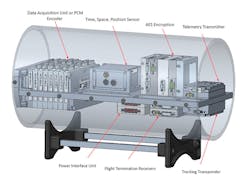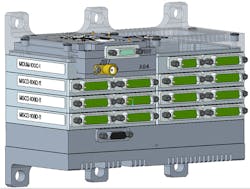Standardize Missile-Test Telemetry with Modular Systems
An essential, but costly, element of any missile program is the telemetry package (telepack) used to acquire flight and performance data for flight test programs. During flight tests, the telemeter typically takes the place of the missile’s warhead. However, in cases where space warrants, smaller telemeters can co-reside in the missile shroud along with the explosives.
Telemeters are used in a wide variety of critical modern missile, pod, and bomb applications, including development testing, weapon simulation, pilot training, and lot sampling. A complete telemeter subsystem will integrate a mix of data-acquisition units (DAUs) to capture and format data; electronics to provide time, space, and position information; batteries; and other components that provide encryption, RF transmission, recording, flight termination, and tracking capabilities, as required (Fig. 1).
Today’s telemeters are custom systems, specifically built by a prime contractor and often using components sourced by multiple vendors for each individual missile platform and test regimen. The different components must be integrated together, adding design and schedule risk.
The custom approach also adds unnecessary costs and program risk, which, by decreasing the affordability of missile programs, can become a hurdle to increased acquisition and deployment. Simply put, the lower the telemeter cost, the more missiles the government can buy. The more expensive the telemeter, the fewer missiles they will buy.
Going Modular to Cut Costs
A better, more cost-effective alternative to today’s custom telemeter designs is to leverage modular architectures based on commercial-off-the-shelf (COTS) hardware to integrate a complete telepack system. An open-architecture approach using proven, pre-qualified data-acquisition modules will not only lower program costs, but will also ease and speed the deployment of telemeters for test programs. Even better, because the standard modules are employed by a wide customer base, it significantly increases telemeter reliability due to broad market feedback and ongoing product improvement.
The use of stackable COTS modules as building blocks (Fig. 2) eliminates the need for complex inter-wiring, thereby easing and speeding the telemeter integration process. They also deliver a high level of architectural flexibility because COTS flight test-instrumentation (FTI) vendors support a vast array of PCM data-acquisition module types.
Every test program is different, and each will likely require some modest amount of telemeter customization. But in general, the chassis and hardware for each telepack will have much in common. A modular architecture makes telemeters easily configurable by either the customer or vendor to meet the exact requirements of each application.
By their nature, modular systems also help mitigate obsolescence, because any obsolete elements are easily and quickly replaced without requiring any modification to the rest of the system. Modularity also brings benefits to new programs. For example, modifying a telemeter for use in a new test program might only require swapping out a single plug-in module and changing some field-programmable gate-array (FPGA) code, instead of having to replace an entire DAU.
The modified telemeter may need some re-qualification, but the cost-effectiveness of a COTS-based telemeter, compared to a custom design, and multiplied by the volumes needed for a missile program, can easily offset any related costs. Also, because the performance parameters of a standard module are well established, the reuse of known COTS components better enables less costly re-qualification via simulation.
Some years ago, a standard building-block approach was introduced in the flight-test market. However, it was unable to gain market traction because its very small form factor made any needed modifications to the telemeter too difficult to be practical. The use of a slightly larger form factor mitigates the failings of that earlier effort while successfully addressing up to 90% of telemeter applications.
An effective COTS-based flight-test telemetry system should offer packaging that can be easily customized to support various mechanical configurations, both in diameter and in length. Look for a supplier whose test capability encompasses EMI compatibility, temperature testing, vibration, altitude, humidity, and shock testing to ensure reliability for a full turnkey solution. Other supplier capabilities should include test equipment for programming, test data analysis, activation, monitoring, and controlling telemetry during lab tests, flight line prelaunch verification, and flight testing.
Summing Up
Moving away from traditional custom telemeter designs, in which components from multiple vendors must be integrated together, to a modern open-architecture model, will significantly reduce the cost of telemeters for development test, pilot test, and lot test applications. It will also provide immediate access to extensive libraries of proven data-acquisition modules.
A fully integrated COTS solution eliminates the complex task of interconnecting individual modules via the stack configuration, because all of the modules simply plug into each other. All that remains is for the flight-test engineer to bring their signals into the telemeter.
Paul Cook is Director of Missile Systems at Curtiss-Wright Defense Solutions.
References
Miniature Double Wide Acquisition System
Reducing Time and Cost of Ordnance Testing with Modern Transponder Designs
Non-Traditional Implementation of a Traditional Safety System
Meeting Missile Program Upgrade Requirements with Power-Efficient, Future Proof Transmitters
Using Aircraft Crash Protected Recorders in Missile Test Applications
About the Author
Paul Cook
Director of Missile Systems, Curtiss-Wright Defense Solutions
Paul Cook is the director of missile systems at Curtiss-Wright Defense Solutions. He has 37 years of extensive design and product-line experience in telemetry systems. He’s held both engineering and management positions in design and development, embedded encryption, RF subsystems and data links, engineering and business management, and program management. Paul has 34 years of experience in the telemetry industry and three years in Information Assurance Type I CCEP certifications.
Cook joined Teletronics in 2007 and worked in the telemetry industry for General Dynamics Corp., Aydin Corp., and L-3 Communications Corp. He obtained a BS degree from the College of New Jersey and has completed various postgraduate courses towards an MBA and Program Management Certifications.


